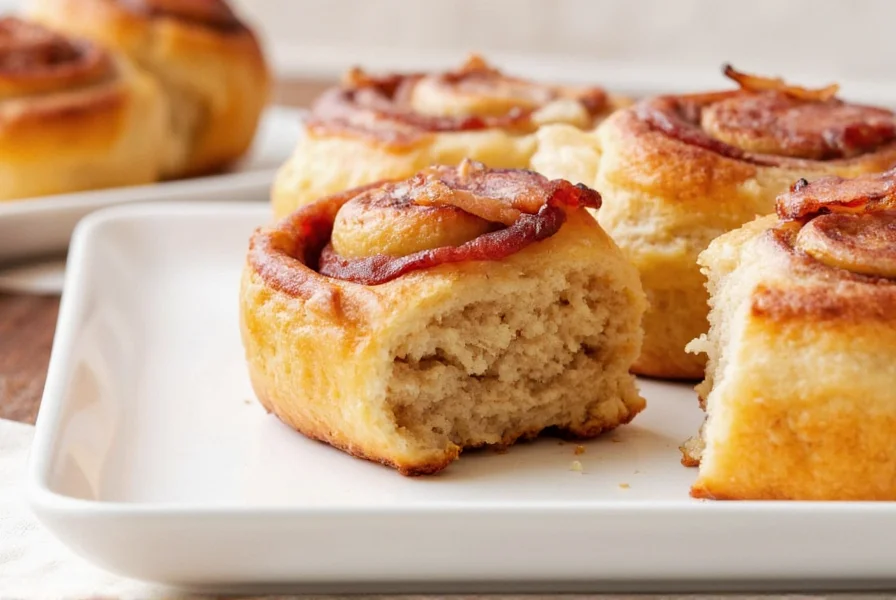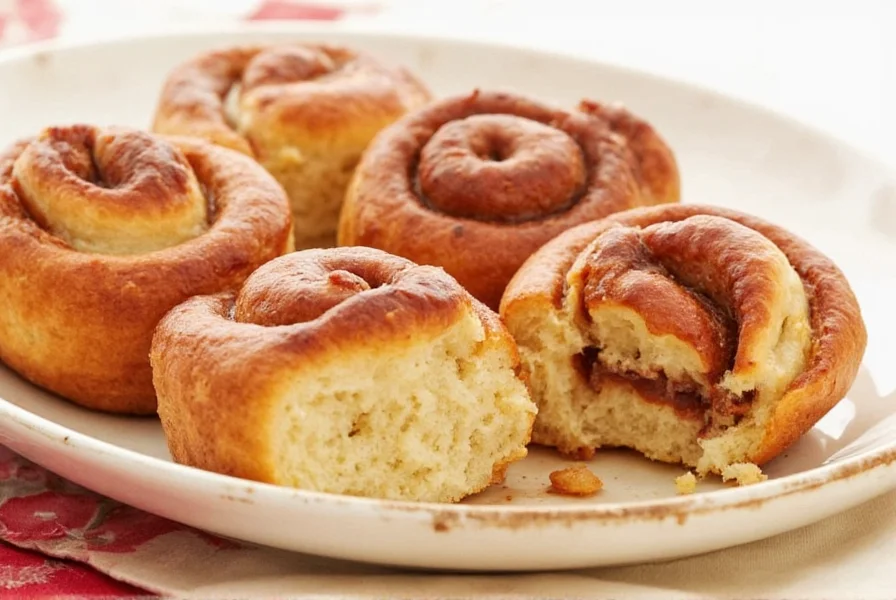| Prep Time | Cook Time | Total Time | Servings |
|---|---|---|---|
| 2 hours | 25 minutes | 2 hours 25 minutes | 12 rolls |
Bacon cinnamon rolls represent one of the most successful sweet-savory breakfast innovations of recent culinary history. Unlike ordinary cinnamon rolls, these elevated pastries incorporate real bacon in multiple components—typically within the filling, as a topping element, and sometimes even infused into the glaze. The magic happens when the saltiness of properly rendered bacon cuts through the sweetness of the cinnamon-sugar mixture, creating a complex flavor profile that satisfies multiple taste receptors simultaneously.
What separates exceptional bacon cinnamon rolls from mediocre versions comes down to three critical factors: bacon preparation technique, dough consistency, and flavor balance. Many home bakers make the mistake of adding raw bacon directly to the filling, which results in uneven cooking and greasy rolls. Professional pastry chefs know that pre-cooking bacon to just shy of crispness—then incorporating small pieces throughout the filling—creates the ideal texture contrast without compromising the delicate dough structure.
Essential Components of Perfect Bacon Cinnamon Rolls
The foundation of outstanding bacon cinnamon rolls begins with understanding each component's role. The dough must be tender enough to pull apart easily yet structured enough to support the weight of the filling. When developing a homemade bacon cinnamon rolls recipe, the yeast ratio is crucial—too much creates large air pockets that cause filling leakage during baking, while too little yields dense, bread-like results.
For the bacon element, thick-cut varieties work best as they maintain texture through the baking process. The optimal approach involves partially cooking the bacon until it's flexible but not crisp, then chopping it finely to distribute evenly through the cinnamon-sugar mixture. This technique ensures each bite contains bacon without creating structural weaknesses in the roll. Some advanced bakers even render bacon fat to replace some of the butter in the dough, adding subtle smokiness throughout the entire pastry.

Step-by-Step Preparation Guide
Creating bakery-quality bacon cinnamon rolls at home requires attention to temperature control and timing. Begin by preparing your bacon first—cook 8 ounces of thick-cut bacon in a cold skillet, allowing the fat to render slowly over medium heat until the strips reach 70% crispness. Remove bacon, reserving 2 tablespoons of fat for the dough, and chop into 1/4-inch pieces.
For the dough, combine 1 cup warm milk (110°F), 2 1/4 teaspoons active dry yeast, and 2 tablespoons sugar in a bowl. Let sit for 5-7 minutes until foamy. In a separate bowl, mix 4 cups all-purpose flour, 1/4 cup sugar, and 1 teaspoon salt. Add the yeast mixture plus 2 tablespoons reserved bacon fat and 1 large egg to the dry ingredients. Knead for 8-10 minutes until smooth and elastic.
Roll the risen dough into a 16x20 inch rectangle. For the filling, combine 1/2 cup softened butter, 1 cup packed brown sugar, 2 tablespoons cinnamon, and the chopped bacon. Spread evenly over the dough, leaving a 1/2-inch border. Roll tightly from the long side, pinch seam to seal, and cut into 12 equal pieces using dental floss for clean slices.
Pro Techniques for Bakery-Quality Results
Professional pastry chefs employ several advanced techniques when preparing maple bacon cinnamon rolls that home bakers can easily adopt. The most impactful involves controlling dough temperature throughout the process—keeping it between 75-78°F during rising prevents over-fermentation that leads to sour flavors. Another critical factor is the filling consistency; too much butter causes leakage, while too little creates dry rolls.
For optimal bacon integration, many chefs use a two-stage cooking method: partially cook the bacon before incorporating it into the filling, then add additional small pieces on top before baking. This creates both internal and external bacon elements with varying textures. The maple glaze should contain real maple syrup rather than artificial flavoring, and be applied while the rolls are still warm but not hot to prevent melting off the surface.
One frequently overlooked aspect in easy bacon cinnamon roll instructions is the resting period after cutting. Allowing the shaped rolls to rest for 20-30 minutes before baking prevents them from spreading too much in the oven while maintaining their defined spiral shape. This resting period also gives the yeast a final boost for optimal rise during baking.
Troubleshooting Common Issues
Even experienced bakers encounter challenges with bacon cinnamon rolls from time to time. If your rolls spread too much during baking, the dough likely rose too long or the filling contained excessive butter. For rolls that remain doughy in the center, try lowering your oven temperature by 25°F and extending baking time—this allows thorough cooking without burning the exterior.
When bacon becomes overly crispy or burnt, you've either added it too early in the cooking process or used thin-cut varieties that cook too quickly. The ideal solution is to incorporate bacon at 70% crispness and consider using a combination of regular and candied bacon for varied texture. For rolls that lack bacon flavor, increase the bacon quantity by 25% or try infusing the dough with a small amount of rendered bacon fat.
Variations for Different Dietary Needs
While traditional bacon cinnamon rolls delight most palates, accommodating different dietary requirements has become increasingly important. For gluten-free bacon cinnamon rolls, a blend of rice flour, tapioca starch, and xanthan gum provides the best structure, though you'll need to reduce rising time by 25% as gluten-free doughs overproof quickly. The bacon element remains unchanged in this variation.
Creating a convincing vegan bacon cinnamon rolls alternative requires thoughtful substitutions. Use coconut bacon or mushroom-based bacon alternatives that mimic the smoky flavor profile, and replace dairy components with plant-based alternatives. The key challenge is maintaining the fat content that bacon normally provides—many successful vegan versions incorporate smoked paprika and liquid smoke to compensate for the flavor dimension lost when omitting traditional bacon.
Storage and Reheating Best Practices
Proper storage ensures your homemade bacon cinnamon rolls maintain quality beyond the initial baking. Store cooled rolls in an airtight container at room temperature for up to 2 days, or freeze individual portions for longer storage. When reheating, the microwave creates uneven results that make the bacon chewy—instead, warm rolls in a 300°F oven for 8-10 minutes to restore the ideal texture balance between soft dough and crisp bacon.
For meal preppers making large batches of bacon cinnamon rolls from scratch, consider assembling but not baking the rolls, then freezing them on a parchment-lined baking sheet before transferring to freezer bags. When ready to serve, thaw overnight in the refrigerator and bake as directed—this method preserves the delicate dough structure better than freezing fully baked rolls.
Frequently Asked Questions
Can I use regular bacon instead of thick-cut for cinnamon rolls?
Yes, but you'll need to adjust cooking time. Regular bacon cooks faster and becomes brittle more easily. Partially cook regular bacon until pliable but not crisp, then chop finely. You may need to reduce the baking time by 3-5 minutes to prevent the thinner bacon from becoming overly crisp during the final bake.
How do I prevent my bacon cinnamon rolls from becoming soggy?
Sogginess typically occurs when bacon isn't sufficiently pre-cooked or when too much butter-based filling leaks out. Cook bacon to 70% crispness before incorporating it, and ensure your filling has the right butter-to-sugar ratio (1:2). Also, allow rolls to cool for 15 minutes before applying glaze to prevent moisture absorption.
What's the best way to incorporate maple flavor without making rolls too wet?
Use real maple syrup in your glaze rather than maple extract, but reduce other liquid components proportionally. For the filling, substitute 25% of the brown sugar with maple sugar, which provides concentrated maple flavor without added moisture. Never add liquid maple syrup directly to the filling as it will make the dough soggy.
Can I prepare bacon cinnamon rolls the night before baking?
Absolutely. Assemble the rolls in your baking dish, cover tightly, and refrigerate overnight. The cold fermentation actually enhances flavor development. When ready to bake, remove from refrigerator 30 minutes before baking to take the chill off, then bake as directed—adding 5-7 minutes to the baking time if needed.











 浙公网安备
33010002000092号
浙公网安备
33010002000092号 浙B2-20120091-4
浙B2-20120091-4